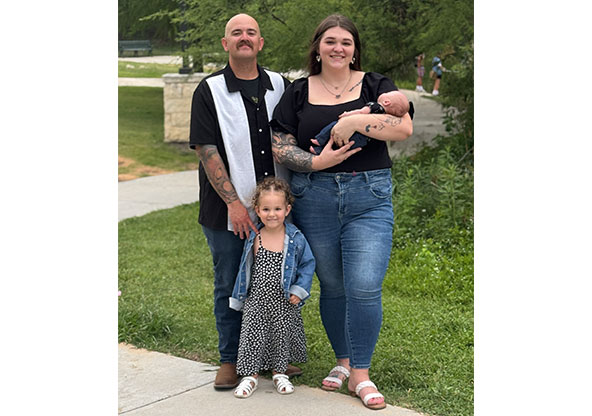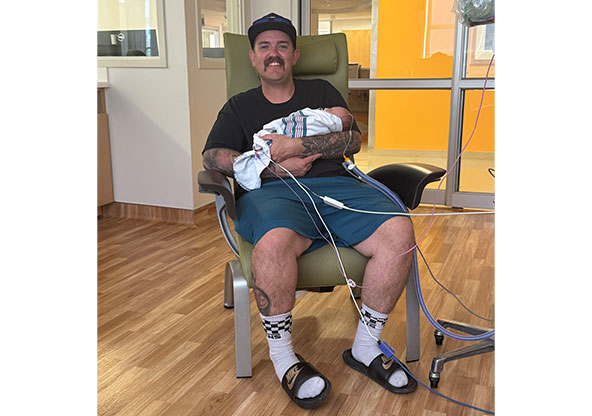Cierra's High-Risk Pregnancy Journey at CHRISTUS Children's
Cierra’s pregnancy felt off from the beginning, but no one could have predicted what was coming: eight weeks of hospital bed rest, an emergency delivery at 30 weeks and another two months living steps from the NICU as her newborn son, Porter, fought to grow stronger each day.
0 to 17 Weeks:
A Placental Hemorrhage, Early Signs of a High-Risk Pregnancy
Originally from California, Cierra and her husband, Jonathan, moved to Texas a few years ago to build a new life for their growing family. With their toddler daughter, Ragan, at home and a wedding on the horizon, another baby wasn’t exactly in the plans—until a friend at a barbecue, noticing Cierra wasn’t feeling well, encouraged her to take a pregnancy test. It was positive right away.
But something about this pregnancy felt different from the very start. There was persistent spotting, unexplained discomfort, and middle-of-the-night pain that landed Cierra in the emergency room more than once. At eight weeks, doctors discovered a small placental hemorrhage, a type of bruise or bleeding between the placenta and the uterine wall. Then, at 12 weeks, everything appeared to be progressing normally again. But Cierra’s anxiety lingered.
I tried to convince myself it was fine, that maybe I was just anxious,
Cierra said. But deep down, I felt like something wasn’t right, and not being able to explain it made it even harder.
Cierra remembers keeping most of her worries to herself at the time. In hindsight, those early signs may have pointed to something more serious. Her amniotic sac had likely ruptured around 17 weeks, well before her baby reached viability.
Fetal Care Center
Care for Your High-Risk PregnancyFetal Care Center
You don't have to go through your high-risk pregnancy alone. With the maternal-fetal care team at CHRISTUS Children's, you will have a dedicated team of highly-trained specialists to walk with you through every step.
17 to 30 weeks:
Living at the Hospital and Extending the Pregnancy
The gravity of the situation wouldn’t come into full focus until just after the 22-week mark, when Cierra’s obstetrician called with difficult news. Her water had indeed broken weeks earlier, and she was now facing a medically fragile pregnancy. She was promptly given 24 hours of antibiotics as her care team at the time worked to determine the next steps.
Cierra and Jonathan both knew they wanted to continue the pregnancy no matter what. Leaning on each other gave Cierra the strength to face what lay ahead.
Because of the complexity of her case and the specialized support required, her OB arranged for her to be transferred to the CHRISTUS Children’s antepartum unit known for its multidisciplinary maternal-fetal medicine program and high-level neonatal care—where she would remain on strict hospital bed rest.
Upon arrival, the care team moved quickly. Cierra was admitted, stabilized and given her first milestone to aim for: 24 weeks, the point when a baby may survive outside the womb with intensive care. From there, it became a day-by-day effort to stretch the pregnancy as far as possible.
I was terrified,
she said. But I was never alone. Every day, one of the four OB-GYN specialists on rotation came in to check on me. They answered every question and didn’t just care about my chart. They cared about me.
Her caregivers included Dr. Florencia Molina, Renata Marquez, CNM, Jana Sullivan, CNM and Sarah Wheeler, CNM,
Dr. Molina, who oversaw much of her care, recalled how carefully the team tailored their approach: For patients like Cierra, our priority is to stretch the pregnancy safely, one day at a time. That meant monitoring the baby’s heart rate and her vital signs around the clock, performing high-resolution ultrasounds every week, checking closely for signs of infection and giving corticosteroids to help the baby’s lungs develop. Every decision was made with Cierra and her baby at the center.
Cierra remembered how the care team explained each step in plain language and included her in every decision. Nurses wheeled her outside so she could feel the sun, and the Child Life Services team made sure her daughter, Ragan, felt welcome during visits—often arriving with toys, games and fun activities.
But despite the kindness and support, long-term hospital bed rest was incredibly hard.
Cierra had limited mobility and long stretches of time to fill. Most days were spent in her hospital bed, watching TV, texting friends or Face Timing with Jonathan and Ragan to stay connected. While she tried to keep herself entertained, the long hours and solitude weighed heavily. Her husband was still working full time and caring for their toddler at home, which added pressure and wore on them both in different ways.
Still, with each passing week, Cierra kept going. She reached 24 weeks. Then 26. Then 28. And by the time she hit 30 weeks, she had given her baby something that once felt impossible: time to grow.
Life in the NICU after a Premature Birth
At 30 weeks, Cierra sensed a shift. Something in her body felt different. During a cervical exam, a sudden gush of blood confirmed a significant bleed.
Within moments, dozens of providers immediately filled the room, coordinating an emergency C-section with practiced urgency. At 4:23 p.m., Porter was born. He was immediately intubated and transferred to CHRISTUS Children’s Level IV Neonatal Intensive Care Unit. Cierra had only a brief opportunity to kiss him before he was whisked away, a moment she still treasures.
Three days after giving birth, Cierra was discharged and moved into the onsite Ronald McDonald House, where families can stay while their child is undergoing treatment. The location allowed her to stay close, visiting the NICU multiple times a day and learning how to care for her preterm baby alongside his clinical team.
Porter would spend the first two months of his life in the NICU, which is equipped to manage the most complex and fragile newborns. The facility is staffed 24/7/365 by board-certified neonatologists, advanced practice providers, respiratory therapists, specialized nurses and developmental care experts.
Porter’s lead NICU physician, Dr. Maria Pierce, worked closely with Cierra to guide his care. With premature infants, our goal is to support and protect every major system—lungs, brain, heart, gut—while helping them transition to life outside the womb,
said Dr. Pierce.
Porter progressed well through each phase of support and showed a steady resilience that was encouraging for his gestational age.
As Porter moved from intubation to continuous positive airway pressure (CPAP) and eventually to breathing on his own, Cierra celebrated each small step forward. She learned how to navigate the NICU environment, participated in daily care routines and collaborated with his care team on decisions about feeding, development, and discharge planning.
One turning point came when the team considered trying a bottle feed. They weren’t sure if Porter was ready, but Cierra advocated to give it a try. He took the bottle and never looked back. It was a breakthrough moment – proof that a mother’s intuition, combined with expert care, could shape his progress.
Today and Looking Ahead
How Mom and Baby are Healing and Growing
Porter went home in mid-April 2025. Now four months old, he’s gaining weight, sleeping through the night and steadily hitting his milestones.
He’ll continue follow-up visits at CHRISTUS Children’s pediatric developmental clinics to ensure he stays on track. But for now, life is full of bottles, diapers and family bonding.
Cierra reflects often on the care that helped her family get here: the specialists who gave her pregnancy a fighting chance, the OB-GYNs and certified nurse midwives who checked on her every day, the NICU nurses who cared for Porter like their own and the Child Life team who never let her feel alone. Each person played a role in carrying them through.
To other parents navigating a complicated pregnancy, she offers this advice: Ask every question. Even if it feels small or silly. And most of all, be gentle with yourself. There’s still a part of me that struggles with guilt. Like I failed him by not carrying him to term. But my body did the best it could. Your body is doing its best too. You didn’t do anything wrong.
At CHRISTUS Children’s, stories like Cierra’s are why the hospital has built a full continuum of care—from maternal-fetal medicine and obstetric support to advanced NICU capabilities and developmental follow-up. Each team is connected. Every family is supported. And every baby gets the strongest possible start.
Visit CHRISTUS Children's website to learn more about maternal-fetal medicine, women’s health services and our NICU.
Children's NICU
CHRISTUS Children's NICU
The Level IV NICU at CHRISTUS Children's in San Antonio offers advanced care for newborns and their families, especially babies born prematurely or with special medical conditions.



